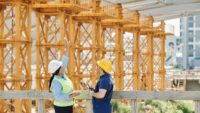Though it’s often characterized as a traditional blue-collar industry, construction has long been at the forefront of technological progress. With a critical role in the buildings we occupy and the infrastructure we use every day, it’s critical that the development of safety, efficiency and structural technologies remains on the cutting edge.
While various improvements have been made over the past few decades particularly in regards to safety new technologies have the potential to provoke sweeping change. The rise of mobile processing and new wireless technologies are allowing for smaller and more mobile devices, and even larger autonomous vehicles. While these technologies may take time to trickle down to every site, they’ve already demonstrated their potential to change the industry.
Bionic builders
One of the most interesting and immediate developments for workers is the exosuit. Think of the power loader from the end of Aliens and you’ll have a sense of the technology, albeit on a slightly different scale. These wearable systems support the arms, legs and back as you carry out manual tasks, alleviating the physical burden of strenuous or repetitive actions.
While the powered systems are the most alluring (with their promises of super-strength and laser beams), it’s the mechanical systems that have seen the earliest use. By distributing and absorbing force, these basic backpack-like exosuits have already been deployed by companies including Ford,1 and made their way to a handful of building firms last year. While there are concerns that some exosuits may transfer forces rather than relieve them, progress has been rapid.
An advance in battery sizes and storage capacities is also on the horizon and could lead to an explosion in powered exosuit technology, with applications everywhere from construction to the military. The increase in the operator’s capabilities could be massive in some cases, and would likely require training to use appropriately, and without endangering others. For now, mechanical systems are the most cost-effective and most likely form of the technology for most workers.
Risk to human workers
The safe and effective use of robots currently relies on a tightly controlled and highly consistent environment, such as those presented in factories and certain warehouses. In many ways this has remained the same since robots were first introduced to car plants in the 1960s; the technology has become safer and more efficient, but not that much more advanced.
Strides have been made in recent years however to increase autonomy, with elements such as mapping of a static environment to prevent the robot from bumping into fixed objects, and sensors to avoid collisions with people. Building sites, however, are highly changeable environments, with potentially greater and more numerous risk factors than the previously mentioned examples. Get this right, however, and robots could undertake all sorts of tasks that pose a risk to human workers.
For a robot or other autonomous vehicle to perform as or more efficiently than traditional manpower, it needs not just mechanical power and precision, but also perfect awareness of its environment something that can be hard enough to instill in people! The rise of AI promises to be the final cog in this wheel, allowing a robot to dynamically assess its surroundings, learn and adapt to new challenges.
Crossover with the development of autonomous cars could see this technology applied to robots on the worksite, with complex sensors and fast data processing helping to avoid collisions, work safely in close quarters to human operators, and navigate rocky ground, or even work at height2. The same battery developments relevant to exosuits could also be deployed here to make the robots fully autonomous, and develop drones to perform work at height without the same risks posed by heavier and less mobile machines.
Access granted
ID systems are already widely used, but on an open site with multiple access points it can be difficult to guarantee that they are properly enforced. A smart ID system can be deployed on a site to keep an eye on entry points with more or less total autonomy. Using a combination of portable cameras and remote sensors, it’s already possible to recognize approved personnel as they enter the site, either through the use of a wireless chip in an ID card or through face recognition.
Perhaps the greatest benefit of this new technology is its portability. Increasingly powerful mobile processing, new wireless technologies and long-life batteries are allowing for multiple portable devices to be networked together, reporting live data back to a base station. This includes not just entry systems but also intruder, fire and gas alarms.
Only a snapshot
What’s incredible is that this is only a snapshot of the new technologies making their way into the construction industry. We didn’t even have time to explore the nascent fields of virtual and augmented reality, which are already making their presence felt in the field of safety training. It may only be a matter of time before VR is a mandatory part of site safety training, and we’re all being fed up-to-the-minute information and instructions by smart glasses and goggles.
While anything that can improve safety and free up resources is to be valued, early adopters will need to be mindful of how they affect people. Exosuits, robots and sensors can only help to protect us if we retain them as a last line of defense, and continue to be vigilant about the risks we encounter every day.
References
- https://www.bbc.co.uk/news/technology-45097046
- https://www.ioshmagazine.com/article/uk-government-invests-ps266m-robots-confined-spaces-and-work-height



